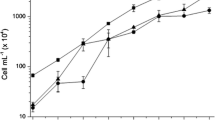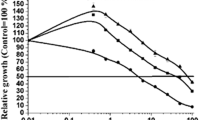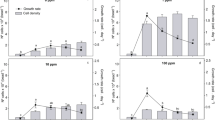Abstract
The development of new strategies in microalgal studies represents an outstanding opportunity to mitigate environmental problems coupled with biomass production at a reduced cost. Here we present a combined bioprocess for the treatment of rice vinasse using immobilized cyanobacteria Synechococcus pevalekii in alginate beads followed by the use of the treated vinasse as a culture medium for Dunaliella salina biomass production. Cyanobacterial-alginate beads showed a chlorophyll a production of 0.68 × 10–3 mg bead−1 and a total carotenoid production of 0.64 × 10–3 mg bead−1. The first step showed a decrease in nitrate (91%), total solids (29%), and ions. Addition of treated vinasse into D. salina cultivation resulted in a significant increase in cell replication of about 175% (optimized cultivation). The use of natural seawater drastically reduced the medium cost to US$4.75 per m3 and the addition of treated vinasse has the potential to reduce it even more (up to 69%). This study not only provides an insight on the use of cyanobacteria for rice vinasse treatment but also demonstrates a promising lower-cost medium for marine microalgal biomass production with biotechnological purposes.






Similar content being viewed by others
References
Lopes ML, de Paulillo SCL, Godoy A et al (2016) Ethanol production in Brazil: a bridge between science and industry. Brazilian J Microbiol 47:64–76. https://doi.org/10.1016/j.bjm.2016.10.003
Embrapa (2012) Embrapa cria arroz para silagem e etanol. https://www.embrapa.br/clima-temperado/busca-de-noticias/-/noticia/1462335/pesquisa-desenvolve--arroz-para-silagem-e-etanol. Accessed 5 Jul 2019
Christofoletti CA, Escher JP, Correia JE et al (2013) Sugarcane vinasse: environmental implications of its use. Waste Manag 33:2752–2761. https://doi.org/10.1016/j.wasman.2013.09.005
Ale R, Jha P, Belbase N (2008) Effect of distillery effluent on some agricultural crops: a case of environmental injustice to local farmers in Khajura VDC, Banke. Sci World 6:68–75. https://doi.org/10.3126/sw.v6i6.2637
Yesilada E (1999) Genotoxic activity of vinasse and its effect on fecundity and longevity of Drosophila melanogaster. Bull Environ Contam Toxicol 63:560–566
Parsaee M, Kiani Deh Kiani M, Karimi K (2019) A review of biogas production from sugarcane vinasse. Biomass Bioenerg 122:117–125. https://doi.org/10.1016/j.biombioe.2019.01.034
Montalvo GEB, Thomaz-Soccol V, Vandenberghe LPS et al (2019) Arthrospira maxima OF15 biomass cultivation at laboratory and pilot scale from sugarcane vinasse for potential biological new peptides production. Bioresour Technol 273:103–113. https://doi.org/10.1016/j.biortech.2018.10.081
Kozieł W, Jaromin-Gleń K, Polakowski C et al (2019) Effect of encapsulated and free-living cells of Chlorella vulgaris L. on nitrogen retention in soils. Int Agrophysics 33:127–136. https://doi.org/10.31545/intagr/104415
Desmet J, Meunier CF, Danloy EP et al (2014) Green and sustainable production of high value compounds via a microalgae encapsulation technology that relies on CO2 as a principle reactant. J Mater Chem A 2:20560–20569. https://doi.org/10.1039/C4TA04659E
Kitcha S, Cheirsilp B (2014) Enhanced lipid production by co-cultivation and co-encapsulation of oleaginous yeast Trichosporonoides spathulata with microalgae in alginate gel beads. Appl Biochem Biotechnol 173:522–534. https://doi.org/10.1007/s12010-014-0859-5
Zeng X, Guo X, Su G et al (2015) Bioprocess considerations for microalgal-based wastewater treatment and biomass production. Renew Sustain Energy Rev 42:1385–1392. https://doi.org/10.1016/j.rser.2014.11.033
Moreno-Garrido I (2008) Microalgae immobilization: current techniques and uses. Bioresour Technol 99:3949–3964. https://doi.org/10.1016/j.biortech.2007.05.040
Borowitzka LJ, Borowitzka MA (1990) Commercial production of β-carotene by Dunaliella salina in open ponds. Bull Mar Sci 47:244–252
Jin ES, Melis A (2003) Microalgal biotechnology: carotenoid production by the green algae Dunaliella salina. Biotechnol Bioprocess Eng 8:331–337. https://doi.org/10.1007/BF02949276
Fu W, Guðmundsson Ó, Paglia G et al (2013) Enhancement of carotenoid biosynthesis in the green microalga Dunaliella salina with light-emitting diodes and adaptive laboratory evolution. Appl Microbiol Biotechnol 97:2395–2403. https://doi.org/10.1007/s00253-012-4502-5
Khadim SR, Singh P, Singh AK et al (2018) Mass cultivation of Dunaliella salina in a flat plate photobioreactor and its effective harvesting. Bioresour Technol 270:20–29. https://doi.org/10.1016/j.biortech.2018.08.071
Acién Fernández FG, Fernández Sevilla JM, Molina Grima E (2019) Costs analysis of microalgae production. Biofuels from Algae. Elsevier, Amsterdam, pp 551–566
Stanier RY, Kunisawa R, Mandel M, Cohen-Bazire G (1971) Purification and properties of unicellular blue-green algae (order Chroococcales). Bacteriol Rev 35:171–205
Walne PR (1966) Experiments in the large scale culture of the larvae of Ostrea edulis. H.M.S.O, London
APHA (2005) Standard methods for the examination of water and wastewater, 21st edn. American Public Health Association, Washington DC
Kirk PL (1950) Kjeldahl method for total nitrogen. Anal Chem 22:354–358. https://doi.org/10.1021/ac60038a038
de Bashan LE, Moreno M, Hernandez J-P, Bashan Y (2002) Removal of ammonium and phosphorus ions from synthetic wastewater by the microalgae Chlorella vulgaris coimmobilized in alginate beads with the microalgae growth-promoting bacterium Azospirillum brasilense. Water Res 36:2941–2948
Lorenzen C (1967) Determination of chlorophyll and pheo-pigments: spectrophotometric equations. Limnol Oceanogr 12:343–346. https://doi.org/10.4319/lo.1967.12.2.0343
Strickland J, Parsons T (1968) A practical handbook of seawater analysis. Fisheries Research Board of Canada, Ottawa
Collos Y, Mornet F, Sciandra A et al (1999) An optical method for the rapid measurment of micromolar concentrations of nitrate in marine phytoplankton cultures. J Appl Phycol 11:179–184. https://doi.org/10.1023/A:1008046023487
España-Gamboa E, Mijangos-Cortes J, Barahona-Perez L et al (2011) Vinasses: characterization and treatments. Waste Manag Res 29:1235–1250. https://doi.org/10.1177/0734242X10387313
Stein LY, Klotz MG (2016) The nitrogen cycle. Curr Biol 26:R94–R98. https://doi.org/10.1016/j.cub.2015.12.021
Nitayavardhana S, Issarapayup K, Pavasant P, Khanal SK (2013) Production of protein-rich fungal biomass in an airlift bioreactor using vinasse as substrate. Bioresour Technol 133:301–306. https://doi.org/10.1016/j.biortech.2013.01.073
dos Santos JD, Lopes da Silva AL, da Luz CJ et al (2013) Development of a vinasse nutritive solution for hydroponics. J Environ Manage 114:8–12. https://doi.org/10.1016/j.jenvman.2012.10.045
Dowd MK, Johansen SL, Cantarella L, Reilly PJ (1994) Low molecular weight organic composition of ethanol stillage from sugarcane molasses, citrus waste, and sweet whey. J Agric Food Chem 42:283–288. https://doi.org/10.1021/jf00038a011
Paz-Pino OL, Barba-Ho LE, Marriaga Cabrales N (2014) Vinasse treatment by coupling of electro-dissolution, heterocoagulation and anaerobic digestion. DYNA 81:102–107. https://doi.org/10.15446/dyna.v81n187.38922
Wilkie AC, Riedesel KJ, Owens JM (2000) Stillage characterization and anaerobic treatment of ethanol stillage from conventional and cellulosic feedstocks. Biomass Bioenerg 19:63–102. https://doi.org/10.1016/S0961-9534(00)00017-9
de Godoi LAG, Camiloti PR, Bernardes AN et al (2019) Seasonal variation of the organic and inorganic composition of sugarcane vinasse: main implications for its environmental uses. Environ Sci Pollut Res. https://doi.org/10.1007/s11356-019-06019-8
Ruiz-Güereca DA, del Sánchez-Saavedra MP (2016) Growth and phosphorus removal by Synechococcus elongatus co-immobilized in alginate beads with Azospirillum brasilense. J Appl Phycol 28:1501–1507. https://doi.org/10.1007/s10811-015-0728-9
Pansook S, Incharoensakdi A, Phunpruch S (2016) Hydrogen production by immobilized cells of unicellular halotolerant cyanobacterium Aphanothece halophytica in alginate beads. Asia-Pacific J Sci Technol 21:248–255. https://doi.org/10.14456/kkurj.2016.34
Covarrubias SA, De-Bashan LE, Moreno M, Bashan Y (2012) Alginate beads provide a beneficial physical barrier against native microorganisms in wastewater treated with immobilized bacteria and microalgae. Appl Microbiol Biotechnol 93:2669–2680. https://doi.org/10.1007/s00253-011-3585-8
Lv J, Feng J, Liu Q, Xie S (2017) Microalgal cultivation in secondary effluent: recent developments and future work. Int J Mol Sci 18:79. https://doi.org/10.3390/ijms18010079
Giraldo Calderón ND, Díaz Bayona KC, Atehortúa Garcés L (2018) Immobilization of the green microalga Botryococcus braunii in polyester wadding: effect on biomass, fatty acids, and exopolysaccharide production. Biocatal Agric Biotechnol 14:80–87. https://doi.org/10.1016/j.bcab.2018.02.006
Kube M, Mohseni A, Fan L, Roddick F (2019) Impact of alginate selection for wastewater treatment by immobilised Chlorella vulgaris. Chem Eng J 358:1601–1609. https://doi.org/10.1016/j.cej.2018.10.065
Liu X, Wang K, Zhang J et al (2019) Ammonium removal potential and its conversion pathways by free and immobilized Scenedesmus obliquus from wastewater. Bioresour Technol 283:184–190. https://doi.org/10.1016/j.biortech.2019.03.038
Touloupakis E, Rontogiannis G, Silva Benavides AM et al (2016) Hydrogen production by immobilized Synechocystis sp. PCC 6803. Int J Hydrogen Energy 41:15181–15186. https://doi.org/10.1016/j.ijhydene.2016.07.075
Tam NF, Wong Y (2000) Effect of immobilized microalgal bead concentrations on wastewater nutrient removal. Environ Pollut 107:145–151. https://doi.org/10.1016/S0269-7491(99)00118-9
Ji L, Song W, Wei D et al (2019) Modified mussel shell powder for microalgae immobilization to remove N and P from eutrophic wastewater. Bioresour Technol 284:36–42. https://doi.org/10.1016/j.biortech.2019.03.112
Zhang E, Wang B, Wang Q et al (2008) Ammonia–nitrogen and orthophosphate removal by immobilized Scenedesmus sp. isolated from municipal wastewater for potential use in tertiary treatment. Bioresour Technol 99:3787–3793. https://doi.org/10.1016/j.biortech.2007.07.011
Soo C-L, Chen C-A, Bojo O, Hii Y-S (2017) Feasibility of marine microalgae immobilization in alginate bead for marine water treatment: bead stability, cell growth, and ammonia removal. Int J Polym Sci 2017:1–7. https://doi.org/10.1155/2017/6951212
Vichez C, Vega JM (1994) Nitrite uptake by Chlamydomonas reinhardtii cells immobilized in calcium alginate. Appl Microbiol Biotechnol 41:137–141. https://doi.org/10.1007/BF00166096
He T, Xie D, Li Z et al (2017) Ammonium stimulates nitrate reduction during simultaneous nitrification and denitrification process by Arthrobacter arilaitensis Y-10. Bioresour Technol 239:66–73. https://doi.org/10.1016/j.biortech.2017.04.125
Ye J, Zhao B, An Q, Huang Y-S (2016) Nitrogen removal by Providencia rettgeri strain YL with heterotrophic nitrification and aerobic denitrification. Environ Technol 37:2206–2213. https://doi.org/10.1080/09593330.2016.1146338
Lei Y, Wang Y, Liu H et al (2016) A novel heterotrophic nitrifying and aerobic denitrifying bacterium, Zobellella taiwanensis DN-7, can remove high-strength ammonium. Appl Microbiol Biotechnol 100:4219–4229. https://doi.org/10.1007/s00253-016-7290-5
Zhao B, An Q, He YL, Guo JS (2012) N2O and N2 production during heterotrophic nitrification by Alcaligenes faecalis strain NR. Bioresour Technol 116:379–385. https://doi.org/10.1016/j.biortech.2012.03.113
Weiss TL, Young EJ, Ducat DC (2017) A synthetic, light-driven consortium of cyanobacteria and heterotrophic bacteria enables stable polyhydroxybutyrate production. Metab Eng 44:236–245. https://doi.org/10.1016/j.ymben.2017.10.009
Tan X, Du W, Lu X (2015) Photosynthetic and extracellular production of glucosylglycerol by genetically engineered and gel-encapsulated cyanobacteria. Appl Microbiol Biotechnol 99:2147–2154. https://doi.org/10.1007/s00253-014-6273-7
Ji M-K, Abou-Shanab RAI, Kim S-H et al (2013) Cultivation of microalgae species in tertiary municipal wastewater supplemented with CO2 for nutrient removal and biomass production. Ecol Eng 58:142–148. https://doi.org/10.1016/j.ecoleng.2013.06.020
Hodges A, Fica Z, Wanlass J et al (2017) Nutrient and suspended solids removal from petrochemical wastewater via microalgal biofilm cultivation. Chemosphere 174:46–48. https://doi.org/10.1016/j.chemosphere.2017.01.107
Vega JM, Menacho A, León J (1991) Nitrate assimilation by microalgae. Trends Photochem Photobiol 2:69–111
Santana H, Cereijo CR, Teles VC et al (2017) Microalgae cultivation in sugarcane vinasse: selection, growth and biochemical characterization. Bioresour Technol 228:133–140. https://doi.org/10.1016/j.biortech.2016.12.075
Barrocal VM, García-Cubero MT, González-Benito G, Coca M (2010) Production of biomass by Spirulina maxima using sugar beet vinasse in growth media. N Biotechnol 27:851–856. https://doi.org/10.1016/j.nbt.2010.07.001
Ramirez NNV, Farenzena M, Trierweiler JO (2014) Growth of microalgae Scenedesmus sp in ethanol vinasse. Brazilian Arch Biol Technol 57:630–635. https://doi.org/10.1590/S1516-8913201401791
Morais DV, Bastos RG (2019) Phycocyanin production by Aphanothece microscopica Nägeli in synthetic medium supplemented with sugarcane vinasse. Appl Biochem Biotechnol 187:129–139. https://doi.org/10.1007/s12010-018-2811-6
Budiyono SI, Sumardiono S, Sasongko SB (2014) Production of Spirulina platensis biomass using digested vinasse as cultivation medium. Trends Appl Sci Res 9:93–102. https://doi.org/10.3923/tasr.2014.93.102
Bartley ML, Boeing WJ, Dungan BN et al (2014) pH effects on growth and lipid accumulation of the biofuel microalgae Nannochloropsis salina and invading organisms. J Appl Phycol 26:1431–1437. https://doi.org/10.1007/s10811-013-0177-2
Gent MPN (2003) Solution electrical conductivity and ratio of nitrate to other nutrients affect accumulation of nitrate in hydroponic lettuce. HortScience 38:222–227. https://doi.org/10.21273/HORTSCI.38.2.222
Larronde-Larretche M, Jin X (2016) Microalgae (Scenedesmus obliquus) dewatering using forward osmosis membrane: influence of draw solution chemistry. Algal Res 15:1–8. https://doi.org/10.1016/j.algal.2016.01.014
Xia A, Murphy JD (2016) Microalgal cultivation in treating liquid digestate from biogas systems. Trends Biotechnol 34:264–275. https://doi.org/10.1016/j.tibtech.2015.12.010
Tran D, Doan N, Louime C et al (2014) Growth, antioxidant capacity and total carotene of Dunaliella salina DCCBC15 in a low cost enriched natural seawater medium. World J Microbiol Biotechnol 30:317–322. https://doi.org/10.1007/s11274-013-1413-2
Sipaúba-Tavares LH, Berchielli-Morais FA, Scardoeli-Truzzi B (2015) Growth of Haematococcus pluvialis flotow in alternative media. Brazilian J Biol 75:796–803. https://doi.org/10.1590/1519-6984.23013
Colusse GA, Duarte MER, de Carvalho JC, Noseda MD (2019) Media effects on laboratory scale production costs of Haematococcus pluvialis biomass. Bioresour Technol Reports 7:100236. https://doi.org/10.1016/j.biteb.2019.100236
Camacho-Rodríguez J, Cerón-García MC, Fernández-Sevilla JM, Molina-Grima E (2015) Genetic algorithm for the medium optimization of the microalga Nannochloropsis gaditana cultured to aquaculture. Bioresour Technol 177:102–109. https://doi.org/10.1016/j.biortech.2014.11.057
Venkataraman L (1997) Spirulina platensis (Arthrospira): physiology, cell biology and biotechnologym, edited by Avigad Vonshak. J Appl Phycol 9(3):295–296. https://doi.org/10.1023/a:1007911009912
Acknowledgements
The authors would like to thank the Oceanographic Institute at the São Paulo University for the S. pevalekii and D. salina strain donation for this study, the Bio4-Soluções Biotecnológicas for the rice vinasse donation, and Prof. Luiz Alberto Junior Letti for assistance with optimization experimental design. GAC and AOS acknowledge doctoral fellowships from Coordenação de Aperfeiçoamento de Pessoal de Nível Superior (CAPES, Brazil). JMR acknowledges a postdoctoral fellowship from CNPq. MRD, JCC, and MDN are Research Members of Conselho Nacional de Desenvolvimento Científico e Tecnológico (CNPq, Brazil).
Funding
This study was funded by the Conselho Nacional de Desenvolvimento Científico e Tecnológico (CNPq)—Brazil [Universal Call grant number: 462414/2014-0]; and Coordenação de Aperfeiçoamento de Pessoal de Nível Superior (CAPES)—Brazil (Finance Code 001).
Author information
Authors and Affiliations
Contributions
Guilherme Augusto Colusse performed the experiments, analysis, and interpretation of data, and wrote the manuscript. André Oliveira Santos and Jenifer Mota Rodrigues assisted in the experiments and data analyses. Marcelo Calide Barga contributed to data acquisition. Maria Eugênia Rabello Duarte and Júlio Cesar de Carvalho revised all analyses and data sets, and contributed to the conception and design of the study. Miguel Daniel Noseda conceived, designed, and supervised the study. All authors reviewed and approved the final manuscript.
Corresponding authors
Ethics declarations
Conflict of interest
The authors declare that they have no conflict of interest.
Additional information
Publisher's Note
Springer Nature remains neutral with regard to jurisdictional claims in published maps and institutional affiliations.
Supplementary Information
Below is the link to the electronic supplementary material.
Rights and permissions
About this article
Cite this article
Colusse, G.A., Santos, A.O., Rodrigues, J.M. et al. Rice vinasse treatment by immobilized Synechococcus pevalekii and its effect on Dunaliella salina cultivation. Bioprocess Biosyst Eng 44, 1477–1490 (2021). https://doi.org/10.1007/s00449-021-02531-9
Received:
Accepted:
Published:
Issue Date:
DOI: https://doi.org/10.1007/s00449-021-02531-9




